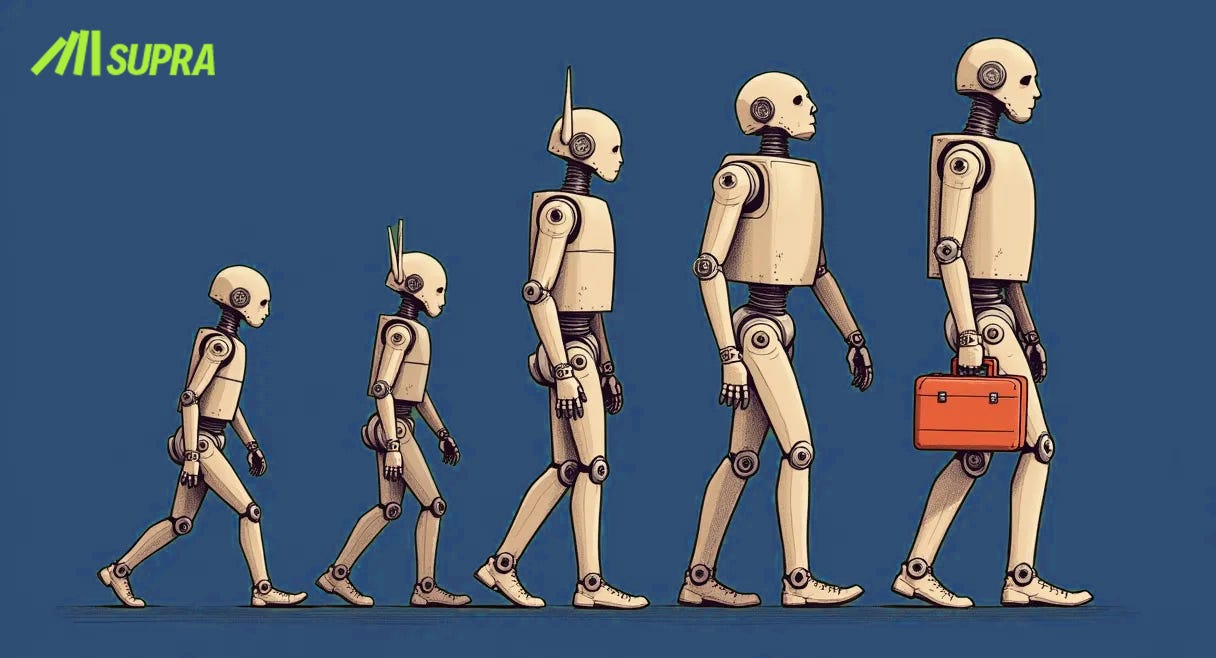How Creative Agencies Survive (and Thrive) in the AI Era
Listen to the audio version here!
That was a strange Monday. While for years Creative Agencies seemed to avoid us at SUPRA like the devil avoids white water, I saw two inquiries from agencies in my mailbox. A few days later another one. No obvious trace was found. Instead, when meeting them they reported to follow me already for a while. In those conversations I learned a lot about their challenges and together we realize – AI is a turning point for Creative Agencies, and it takes a different strategy to survive. Let me break it down.
Flashback 2017, I am presenting at a conference full of creatives some (IMHO) groundbreaking work that I called CREATIVE AI. Obviously, I did not explain well enough how AI and creative minds could be a perfect match, because the audience became furious. “How can you claim to replace creativity!” (I did not) or “you can never explain the creative genius” (I did not try to). Long story short – Creatives and AI did find common ground.
8 years in - the world has changed:
Upskilling: AI and automation tools (e.g., for copy, design, editing, data analysis) are evolving fast—clients expect agencies to be fluent in them.
War for Talents: Creative talent is lured away by flexible freelance life or stable in-house brand teams. Mid-size agencies struggle to offer the same perks, growth paths, or work/life balance.
Competition: Clients are flooded with “cheap and fast” options (freelancers, AI tools, platforms). The value of big ideas and strategic thinking risks being undermined by tactical content production.
Data muscle: Clients want creative agencies that perform—and they want proof. The dichotomy creativity vs evidence is massively eroding.
While very large agencies are trying to cope by building their own data and AI teams, midsize agencies need to leverage their own strength to be able to compete.
An important realization paves the way for the “winning formula”: While AI is useful for everyone, those who ask better questions and those who are able to critically question and challenge the output in order to squeeze the AI for higher quality output, those will create content and insights that are a multitude more impactful than standard output. Ethan Mollick calls it “The Expert Paradoxon”.
Therefore, true expertise will be more important, not less in the AI age. Being able to win and keep top talents will be existential.
This means for agencies to focus your work on niche competency. This will be those competencies you have the best experts (who squeeze the AI). For everything else you need to collaborate with other vendors who apply the same strategy: Being the best in their fields through domain leadership.
The kicker: the same logic applies to clients, even enterprise clients. It will be hard for brands to win and keep top experts for everything – more than ever even the largest brands will reach out to expert vendors who simply can better squeeze AI.
This means Creative Agencies should form alliances with Insights & Analytics vendors. Doing this they will provide a much more powerful service than the mediocre insights & analytics work that 90% of enterprises are conducting today.
Let’s break it down
To navigate the AI landscape, we must distinguish between three fundamentally different types of AI:
Generative AI: This includes tools like ChatGPT, Midjourney, Veo2, Suno and even vibe coding tools like Replit. This is the operating system of future work. Everyone needs to adapt to this and keep adopting as the field evolves.
Predictive AI: These domain-specific systems forecast specific outcomes. For example, eye-tracking models predict where people will look in an image, which emotions a sound produces or how well a spot will perform in a copy test. Predictive AI leverages specialized datasets to accomplish highly specific tasks. Every agency needs to use them in order to speed up the agile test and learn cycle in order to achieve the most impactful creatives.
Causal AI: Unlike Predictive AI, which tells you what might happen, Causal AI identifies why things happen. It uncovers the drivers behind success or failure and provides actionable insights to influence outcomes.
Generative AI helps to save cost and time. Same does Predictive AI.
But Causal AI is different. It’s not saving costs or time, it creates growth! It provides the ages old question on WHY. It gives more impactful insights on what action, tactics, strategies are creating outcomes.
Causal AI is a multiplier.
Every marketer, insights professional, and data scientist engages in causal analysis—trying to determine why certain strategies work (or fail). However, most methods they use today are flawed, relying on confirmation bias rather than true exploration.
Causal AI changes the game by applying self-learning techniques that uncover unknown relationships between marketing tactics and business outcomes.
This is how Causal AI has driven growth for brands:
T-Mobile USA: Used Causal AI to dissect and refine its 2013 strategy, leading to 4x revenue growth and a turnaround from losses to profitability.
Apple Vision Pro: Neuro-market research with Causal AI revealed that while intuitive control was a major selling point, customers didn’t trust it would work. Addressing this insight was key to launch success.
Samsung: Digital ads initially created with Generative AI saw a breakthrough in performance when Causal AI identified the Brand Archetypes that resonated most with audiences.
Läderach: The luxury chocolate brand used Causal AI to pinpoint local store-level tactics that boosted foot traffic and sales.
Nonprofits: A Causal AI-optimized direct mail strategy increased donor conversion rates by 40%.
Sonos: Analyzing NPS feedback with Causal AI revealed that reliable streaming (not just sound quality) was the key to customer satisfaction—leading to a 10-point NPS increase in six months.
Just Eat: Causal AI-enhanced touchpoint models uncovered that driver appearance directly negatively impacted brand perception, prompting crucial operational improvements.
“Growth Requires Better Marketing…
Which Requires Better Insights…
Which Requires Causal AI.”
We no longer need employees with textbook knowledge—AI knows that 100x better. Instead, we need experts who can critically assess AI’s output and enhance its effectiveness by asking better questions. AI automates standard know-how work and basic human intelligence. But if companies leave AI in the hands of employees with only surface-level expertise, they risk veering off course.
It’s not enough to be 10x better with AI if your competitors are using it to get 100x better.
AI is on its way to AGI. It’s a “beast” that is in some ways smarter than humans. How can we use it rightly if you cannot speak with it at eye level?
Brands need a tamer for that beast. This tamer is a distinguished expert in his field. Based on this here is the winning formula for creative agencies
Adopt and keep up to date with the latest Generative AI and Predictive AI tools
Specialize in niches that you lead with your expertise
Establish alliances with expert leaders in the insights space, ideally with those who leverage Causal AI as the multiplying for impact
This trilogy will then be attractive to top talents and experts. Top performers want to join the best, pretenders and wannabees want to join the biggest.
This is how you win.
This is how Creative Agencies 10x impacts you and your clients.





